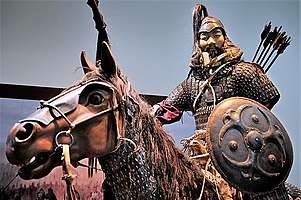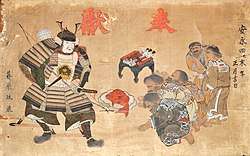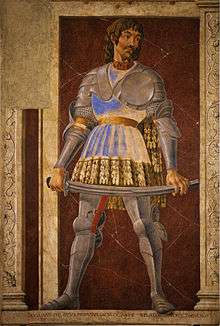Warrior
A warrior is a person specializing in combat or warfare, especially within the context of a tribal or clan-based warrior culture society that recognizes a separate warrior class or caste.

| Part of a series on |
| War |
|---|
|
|
|
Related
|
History


Warriors seem to have been present in the earliest pre-state societies. Along with hunting, war was considered to be a definitive male activity. No matter the pretext for combat, it seemed to have been a rite of passage for a boy to become a man. Warriors took upon costumes and equipment that seemed to have a symbolic significance; combat itself would be preceded by ritual or sacrifice. Men of fighting age often lived apart in order to encourage bonding, and would ritualise combat in order to demonstrate individual prowess among one another.[1] Most of the basic weapons used by warriors appeared before the rise of most hierarchical systems. Bows and arrows, clubs, spears, and other edged weapons were in widespread use. However with the new findings of metallurgy, the aforementioned weapons had grown in effectiveness.[2]
When the first hierarchical systems evolved 5000 years ago, the gap between the rulers and the ruled had increased. Making war to extend the outreach of their territories, rulers often forced men from lower orders of society into the military role. This had been the first use of professional soldiers —a distinct difference from the warrior communities.[3]
The warrior ethic in many societies later became the preserve of the ruling class. Egyptian pharaohs would depict themselves in war chariots, shooting at enemies, or smashing others with clubs. Fighting was considered a prestigious activity, but only when associated with status and power. European mounted knights would often feel contempt for the foot soldiers recruited from lower classes. In Mesoamerican societies of pre-Columbian America, the elite aristocratic soldiers remained separated from the lower classes of stone-throwers.[4] The samurai were the hereditary military nobility and officer caste of Japan from the 12th to the late 19th century.[5]
In contrast to the belief of the caste and clan based warrior who saw war as a place to attain valor and glory, warfare was a practical matter that could change the course of history. History always showed that men of lower orders who, provided that they were practically organized and equipped, almost always outfought warrior elites through an individualistic and humble approach to war. This was the approach of the Roman legions who had only the incentive of promotion, as well as a strict level of discipline. When Europe's standing armies of the 17th and 18th centuries developed, discipline was at the core of their training. Officers had the role of transforming men that they viewed as lower class to become reliable fighting men.[4]
Inspired by the Ancient Greek ideals of the 'citizen soldier', many European societies during the Renaissance began to incorporate conscription and raise armies from the general populace. A change in attitude was noted as well, as officers were told to treat their soldiers with moderation and respect. For example, men who fought in the American Civil War often elected their own officers. With the mobilization of citizens in the armies sometimes reaching the millions, societies often made efforts in order to maintain or revive the warrior spirit. This trend continues to the modern day.[6] Due to the heroic connotations of the term "warrior", this metaphor is especially popular in publications advocating or recruiting for a country's military.[7]
Warrior communities
- Akinji[8]
- Al-Haras
- Praetorian Guard
- Armatoloi[9]
- Ashigaru[10]
- Batavi
- Berserker[11]
- Bogatyr[12]
- Boyars[13]
- Sacred Band of Carthage[14]
- Sacred Band of Thebes
- Cheyenne[15]
- Comitatus
- Condottieri[16]
- Cossacks[17]
- Crusader[18]
- Curetes[19]
- Dacians
- Dog soldier[20]
- Druzhina
- Eagle warrior
- Eso Ikoyi
- Gabiniani
- Ghazi[21]
- Garhwali
- Gladiator
- Gurkha
- Hajduks[22]
- Harii
- Hashashin[23]
- Hersir[24]
- Herules
- Highlander[25]
- Hippeis[26]
- Hird
- Hoplite[27]
- Hospitaller[18]
- Housecarl
- Hulubalang[28]
- Hyksos
- Hwarang[29]
- Immortals[30]
- Impi
- Jaguar warrior[31]
- Janissary[32]
- Karaiyar[33]
- Karava [34]
- Kassites
- Khalsa[35]
- Kheshig[36]
- Kipchaks[37]
- Klephts[9]
- Knights[38][39][40]
- Kshatriya[41]
- Kshetri[42]
- Leidang
- Maccabees[43]
- Mangudai[44]
- Mamluk[45]
- Maravar[46]
- Maryannu
- Maori[47]
- Mongols
- Morlachs
- Moro People
- Medjay
- Meenas
- Mesedi
- Mingghan[48]
- Mukkuvar [49]
- Nair[50]
- Ninja[51]
- Normans
- Numerus Batavorum
- Optimatoi
- Rajput[52]
- Reddy[53]
- Ror[54]
- Rus' people
- Samurai[55]
- Scordisci[56]
- Sengunthar[57]
- Shaolin[58]
- Shieldmaiden[59]
- Sipahi[60]
- Sohei[61]
- Somatophylakes
- Spartan[62]
- Templar[18]
- Teutonics[18]
- Thingmen
- Triballi[63]
- Uskoks[64]
- Vanniar (Chieftain)[65]
- Varangian Guard
- Velir[66]
- Voynuks[67]
- Vikings[68]
See also
References
- Grant, R.G (2007). Warrior: A Visual History of the Fighting Man. Penguin. p. 8. ISBN 978-0-7566-3203-8.
- Grant, R.G (2007). Warrior: A Visual History of the Fighting Man. Penguin. p. 14. ISBN 978-0-7566-3203-8.
- Grant, R.G (2007). Warrior: A Visual History of the Fighting Man. Penguin. p. 9. ISBN 978-0-7566-3203-8.
- Grant, R.G (2007). Warrior: A Visual History of the Fighting Man. Penguin. p. 10. ISBN 978-0-7566-3203-8.
- Harry D. Harootunian, "The progress of Japan and the Samurai class, 1868-1882." Pacific Historical Review (1959) 28#3: 255-266. online
- Grant, R.G (2007). Warrior: A Visual History of the Fighting Man. Penguin. p. 11. ISBN 978-0-7566-3203-8.
- e.g. Wong, Leonard, "Leave No Man Behind: Recovering America’s Fallen Warriors." Armed Forces & Society, July 2005; vol. 31: pp. 599-622.; Bradley C.S. Watson, "The Western Ethical Tradition and the Morality of the Warrior." Armed Forces & Society, October 1999; vol. 26: pp. 55-72; Samet, Elizabeth D., "Leaving No Warriors Behind: The Ancient Roots of a Modern Sensibility." Armed Forces & Society, July 2005; vol. 31: pp. 623-649; Miller, Laura L. and Charles Moskos, "Humanitarians or Warriors?: Race, Gender, and Combat Status in Operations Restore Hope." Armed Forces & Society, July 1995; vol. 21: pp. 615-637
- Bruno Mugnai; Christopher Flaherty (23 September 2014). Der Lange Türkenkrieg (1593-1606): The long Turkish War. Soldiershop. p. 47. ISBN 978-88-96519-91-2.
- Nicholas Charles Pappas (1982). Greeks in Russian military service in the late eighteen and early nineteenth centuries. Stanford University. p. 99.
- Craig, Matthew. Ashigaru - Samurai Combat in the Age of the Country at War. Junkhouse. p. 48. ISBN 9781300185680. Retrieved 3 February 2018.
- Johnson, E. Patrick; Riviera, Ramon H. (2016-05-19). Blacktino Queer Performance. Duke University Press. ISBN 9780822374657.
- Emerson, Caryl (2008). The Cambridge Introduction to Russian Literature. Cambridge University Press. p. 71. ISBN 9781139471688.
- Crummy, Robert (2014). Aristocrats and Servitors: The Boyar Elite in Russia, 1613-1689. Princeton University Press. p. 12. ISBN 9781400853694.
- Head, Duncan "Armies of the Macedonian and Punic Wars 359 BC to 146 BC" (1982), p140.
- Tucker, Phillip (2017). Death at the Little Bighorn: A New Look at Custer, His Tactics, and the Tragic Decisions Made at the Last Stand. Skyhorse Publishing. p. Chapter 2. ISBN 9781634508063. Retrieved 3 February 2018.
- Lenman, B., Anderson, T. Chambers Dictionary of World History, p. 200
- Coker, Christopher (2007). The Warrior Ethos: Military Culture and the War on Terror. Routledge. ISBN 9781134096350.
- Grant, R.G (2007-09-17). Warrior: A Visual History of the Fighting Man. Penguin. p. 78. ISBN 9780756644031.
- Preston, Claire (2006). Bee. Reaktion Books. p. 118. ISBN 9781861892560. Retrieved 3 February 2018.
- Hoig, Stan (Jul 31, 1990). The Peace Chiefs of the Cheyennes. University of Oklahoma Press. p. 85. ISBN 9780806122625. Retrieved 3 February 2018.
Dog soldier warrior.
- Sohail H. Hashmi (3 July 2012). Just Wars, Holy Wars, and Jihads: Christian, Jewish, and Muslim Encounters and Exchanges. Oxford University Press, USA. p. 196. ISBN 978-0-19-975503-5.
- Suraiya Faroqhi (28 April 1997). An Economic and Social History of the Ottoman Empire. Cambridge University Press. pp. 437–438. ISBN 978-0-521-57455-6.
- Kumar, Ram (2012). Martyred but Not Tamed: The Politics of Resistance in the Middle East. SAGE Publishing India. ISBN 9788132117254.
- Chartrand, Rene; Durham, Keith; Harrison, Mark; Heath, Ian (2016). The Vikings. Bloomsbury Publishing. p. 43. ISBN 9781472813220. Retrieved 3 February 2018.
- L. Alcock (2003). Kings and Warriors, Craftsmen and Priests in Northern Britain AD 550–850. Edinburgh: Society of Antiquaries of Scotland. p. 56. ISBN 0-903903-24-5.
- Marinatos, Nanno (2002). My library My History Books on Google Play Goddess and the Warrior: The Naked Goddess and Mistress of the Animals in Early Greek Religion. Routledge. pp. 2–82. ISBN 1134601476.
- Neer, Richard T. (2012). Greek art and archaeology : a new history, c. 2500-c. 150 BCE. New York. p. 95. ISBN 9780500288771. OCLC 745332893.
- A. Samad Ahmad (1979). Sulalatus Salatin (Sejarah Melayu). Dewan Bahasa dan Pustaka. pp. 44–45. ISBN 983-62-5601-6.
- Rutt, p. 22
- Hicks, Jim (1975). The Persians. Time-Life Books.CS1 maint: ref=harv (link)
- Sánchez-Murillo, R. (2012). La palabra universal. Ricardo Sánchez-Murillo. Retrieved September 5, 2012, from link Archived 2013-10-29 at the Wayback Machine.
- Cleveland, Bunton, William, Martin (2013). A History of the Modern Middle East. Westview Press. p. 43. ISBN 978-0-8133-4833-9.
- Das, Sonia N. (2016). Linguistic Rivalries: Tamil Migrants and Anglo-Franco Conflicts. Oxford University Press. ISBN 9780190461782.
- Pārati, Paktavatcala (1999). Coromandel fishermen: an ethnography of Paṭṭaṇavar subcaste. Pondicherry Institute of Linguistics and Culture. p. 9. ISBN 9788185452098.
- Purnima Dhavan (3 November 2011). When Sparrows Became Hawks: The Making of the Sikh Warrior Tradition, 1699-1799. Oxford University Press, USA. pp. 3–. ISBN 978-0-19-975655-1.
- David Christian A history of Russia, Central Asia, and Mongolia, p.396
- Timothy May (7 November 2016). The Mongol Empire: A Historical Encyclopedia [2 volumes]: A Historical Encyclopedia. ABC-CLIO. p. 221. ISBN 978-1-61069-340-0.
- D'A. J. D. Boulton, "Classic Knighthood as Nobiliary Dignity", in Stephen Church, Ruth Harvey (ed.), Medieval knighthood V: papers from the sixth Strawberry Hill Conference 1994, Boydell & Brewer, 1995, pp. 41–100.
- Frank Anthony Carl Mantello, A. G. Rigg, Medieval Latin: an introduction and bibliographical guide, UA Press, 1996, p. 448.
- Charlton Thomas Lewis, An elementary Latin dictionary, Harper & Brothers, 1899, p. 505.
- Fowler, Hinduism (1997), pp. 19–20.
- Adhikari, Indra (2015-06-12). Military and Democracy in Nepal. Routledge. ISBN 9781317589068.
- Cohn, Marc (2007). The Mathematics of the Calendar. p. 60. ISBN 978-1430324966.
- Chambers, James (2003). The Devil's Horsemen: The Mongol Invasion of Europe. Edison, New Jersey: Castle Books. ISBN 978-0-7858-1567-9.
- Christopher Tyerman (2007). God's War: A New History of the Crusades. Penguin Books Limited. p. 156. ISBN 978-0-14-190431-3.
- Hardgrave, Robert L. (1969). The Nadars of Tamilnad. University of California Press. pp. 279.
maravar.
- "Table 1. First, Second, and Total Responses to the Ancestry Question by Detailed Ancestry Code: 2000". census.gov. US Census Bureau.
- Lusted, Marcia Amidon (2017). Genghis Khan and the Building of the Mongol Empire. New York: The Rosen Publishing Group, Inc. p. 32. ISBN 9781499463521.
- McGilvray, Dennis B. (1974). Tamils and Moors: caste and matriclan structure in eastern Sri Lanka. University of Chicago. p. 95.
- Fisher, Michael (2007). Visions of Mughal India: An Anthology of European Travel Writing. I.B Taurus and Co. p. 26. ISBN 978-1-84511-354-4.
- Ratti & Westbrook 1991, p. 325
- Mazumder, Rajit K. The Indian Army and the Making of Punjab. pp. 99, 105.
- Bayly, Susan (2004-04-22). Saints, Goddesses and Kings: Muslims and Christians in South Indian Society, 1700-1900. Cambridge University Press. p. 25. ISBN 9780521891035.
- Shome, Ayan (November 2014). Dialogue & Daggers:Notion of Authority and Legitimacy in the Early Delhi Sultanate 1192 C.E.-1316 C.E. p. 167. ISBN 9789384318468.
- "Samurai (Japanese warrior)". Encyclopædia Britannica.
- Marjeta Šašel Kos (2005). Appian and Illyricum. Narodni Muzej Slovenije. p. 144. ISBN 978-961-6169-36-3.
- Mines, Mattison (1984). The Warrior Merchants: Textiles, Trade and Territory in South India. Cambridge University Press. p. 13. ISBN 9780521267144.
- Chlumsky, Nathan (2015-05-06). Inside Kungfu: Chinese Martial Arts Encyclopedia. p. 19. ISBN 9781329119420.
- The article Sköldmö in Nordisk familjebok (1917).
- Hans Delbrück (1990). Medieval Warfare: History of the Art of War. University of Nebraska Press. p. 474. ISBN 978-0-8032-6585-1.
- Kenkyusha's New Japanese-English Dictionary, ISBN 4-7674-2015-6
- Harley, T. Rutherford. The Public School of Sparta, Greece & Rome, Vol. 3, No. 9 (May 1934) pp. 129-139.).
- Edgar Sanderson; John Porter Lamberton; Charles Morris (1909). Six Thousand Years of History: Famous warriors. T. Nolan. p. 6.
- Suraiya Faroqhi (30 January 2014). Travel and Artisans in the Ottoman Empire: Employment and Mobility in the Early Modern Era. I.B.Tauris. p. 11. ISBN 978-1-78076-481-8.
- Holt, John (2011-04-13). The Sri Lanka Reader: History, Culture, Politics. Duke University Press. p. 86. ISBN 9780822349822.
- Pivot politics: changing cultural identities in early state formation processes. Het Spinhuis. 1994. p. 165. ISBN 9789055890071.
- Historical Abstracts: Modern history abstracts, 1450-1914. American Bibliographical Center, CLIO. 1985. p. 644.
- Karl Bihlmeyer; Hermann Tüchle (1967). Church History: The Middle Ages. Newman Press. p. 26.
Bibliography
- Ayvazyan A. "The Code of Honor of the Armenian Military (4-5th centuries)" (2000).
- Shannon E. French, Code of the Warrior - Exploring Warrior Values Past and Present (2003).
- Marion F. Sturkey "Warrior Culture of the U.S. Marines" (2001)